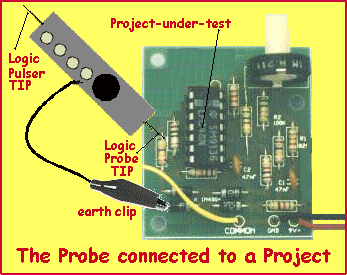Table Of Contents
USING THE LOGIC PROBE
To use the Logic Probe section of the project, connect the “earth” (the alligator clip on the lead) to the earth (0v rail) of the project you are testing. Switch the Logic Probe ON and a short beep may be heard. Place the probe tip on the earth rail to prove the Logic Probe is detecting a LOW and repeat for the power rail. Since the power rail for the project-under-test and the Logic Probe are separate, you need to make sure the Logic Probe will see the power rail as a HIGH - that’s the purpose of the pre-testing we just covered.
Note: The project-under-test must be operating on a supply voltage of at least 5v. If it works on a voltage as low as 3v, the Logic Probe will not (may not) recognise the 3v as a HIGH.
This is one of the limitations of some Logic Probes - except those that connect directly to the project-under-test.
You are now ready to take a test. Place the probe on one of the components in the diagram below (or one of the tracks) on the project-under-test. The Logic Probe will emit either a HIGH tone, LOW tone or a beeping sound. This will indicate, a HIGH, a LOW or a SIGNAL is present on the line.

The Project-under-test must be connected to its power source and SWITCHED ON.
i.e: It must be turned ON. The probe will produce a HIGH, LOW or Pulsed tone from the piezo.
You cannot determine the frequency of the signal on a line, from the sound emitted by the Logic Probe. It only indicates a signal is present. A “signal line” is also called an “active line,” or “digital line” and may be a clock line to another chip or a “bus line” in a complex computer project. If you need to know more details about the quality, frequency or pattern of the signal, a CRO (Cathode Ray Oscilloscope) will be needed.
TESTING CIRCUITS WITH THE LOGIC PROBE
The Logic Probe can also be used to test all types of circuits, providing the waveform has an amplitude of at least 5v. In general, if the signal in a circuit will trigger a microcontroller, it will also be large enough to be detected by this Logic Probe.
Before using the Logic Probe for the first time, you must be sure it is operating correctly. The 5x7 Display Project provides an ideal project to test the operation of the “Probe.”
Some of the lines of the micro in the 5x7 are turning on and off at a fairly fast rate. Pins 6 to 12 drive the anodes of the LED display and these are active when the display is illuminating. Probing these lines will activate both the HIGH and LOW LEDs on the “Probe.”
The clock line to the “shift-chip - a 4017” (pin 17) is activated for a very short period of time and is low for a very long period of time (in computer terms) and the HIGH LED on the “Probe” will glow fairly dull while the green LED will be very bright. A faint beep will be heard from the piezo along with the high tone.
A very brief pulse can be detected on the reset line to the 4017 (pin 18) and this will prove the Logic Probe is capable of detecting a glitch or pulse.
When the Logic Probe has been tested for performance, it is ready for testing “unknown” circuits.
- Go to: Introduction to the Logic Probe with Pulser - discusses how the project works etc
- Go to: Using the Logic Pulser - Testing circuits with the Logic Pulser
Quick Links
Legal Stuff
Social Media


